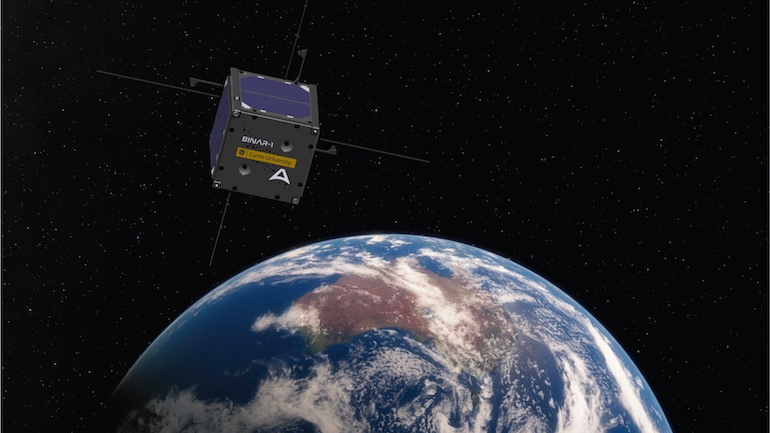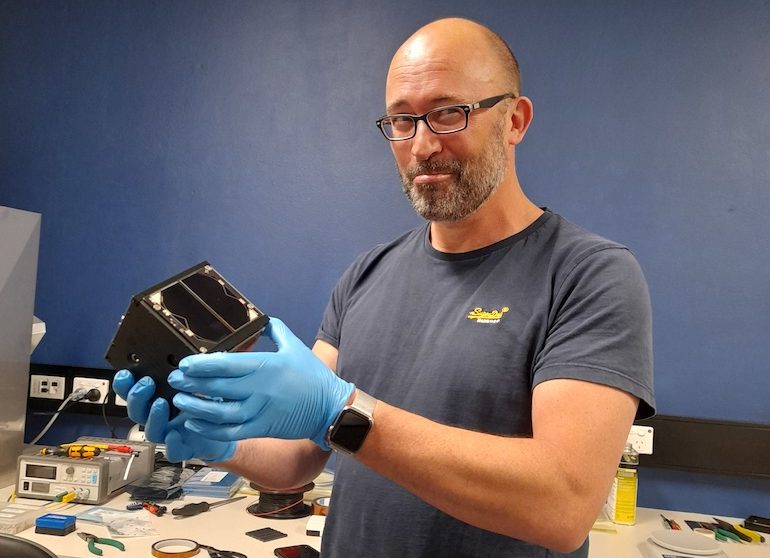A satellite designed and built by staff and students from Curtin University’s Space Science and Technology Centre (SSTC) is set to head to space this week aboard the SpaceX mission to the International Space Station (ISS).
The Binar-1 CubeSat is Western Australia’s first home-grown satellite and will be part of the cargo aboard the SpaceX rocket scheduled to take off from Cape Canaveral, Florida on August 28. It will be deployed from the ISS.
Curtin Vice-Chancellor Professor Harlene Hayne said the Binar Space Program would deliver game-changing national space capability.
“The team has also developed an outstanding school outreach program to put space technology in the hands of students, giving them hands-on experience and real-world inspiration to generate the space workforce of the future right here in WA,” he said.
“It will also further advance Curtin’s goal of enriching WA’s economy and workforce, by linking the Binar Program with local industries and connecting them with a real pathway to the burgeoning space sector.”
Binar (pronounced BIN-ah) is named for the Noongar word for fireball.
SSTC Director Professor Phil Bland said the launch of Binar-1 was the first of seven launches planned over the next 18 months under the program.
For context, in its history our nation has only flown 15 Australian-built spacecraft. Our novel design allows us to make spacecraft affordable, and space accessible for WA innovators,” he said.
“We will be able to control and command our missions from Perth through Fugro’s Australian Space Automation, Artificial Intelligence and Robotics Control Complex (SpAARC), which will use Binar cubesats to test remote operation protocols on a spacecraft in orbit.”
Prof Bland said the group’s ultimate goal is to have a WA-built spacecraft at the Moon by 2025.
“The launch of Binar-1 is our first real step towards that goal. Being able to build spacecraft affordably means that we can rapidly iterate technology, which is a key element in developing advanced systems for exploration, that then also benefit other industry sectors,” he said.
Curtin’s Moon mission will also enable WA to build and operate Binar CubeSats, at scale, to support defence, science, commercial and civil space missions.
WA Premier Mark McGowan said the Binar program was a strong partnership between industry and academia.
“The launch of Binar-1 positions WA as a major player in Australia’s space sector, driving the diversification of its economy into a future-focused industry and creatinga new, highly skilled workforce with capabilities that are easily transferrable between the space and other sectors, such as mining and resources,” he said.
After launch, it will take about a day for Binar-1 to travel to the ISS. The spacecraft will then be deployed into low earth orbit where the team will make contact with the ground station at Curtin University. The primary objective of Binar-1 is to test all the critical spacecraft systems that will help take us towards the Moon.
The two cameras on board Binar-1 will aim to capture images of the WA coastline and relay them back to Earth.
Further information on the Binar Program, including the timing of the Binar-1 launch and links to watch it in real time, can be found at binarspace.com.





















Trending
Daily startup news and insights, delivered to your inbox.